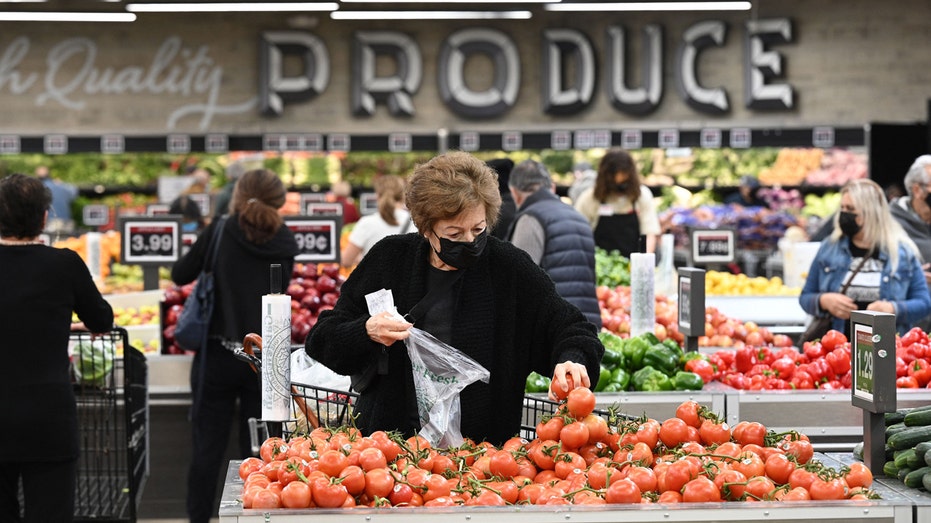https://www.cnbc.com/2022/05/12/european-markets-investors-digest-us-inflation-data-for-april.html
Author: Consultant
-
Finland’s leaders say country should apply for NATO membership ‘without delay’
Finland’s President Sauli Niinisto and Prime Minister Sanna Marin said Thursday that the country should apply to join NATO “without delay.”
Thursday’s announcement is the strongest sign yet that Finland will make a formal application to join NATO. Membership would be historic for the Nordic country, which has had a decades-long policy of military neutrality.
“Finland must apply for NATO membership without delay.” the leaders said in a joint statement, adding that they hoped that “the national steps still needed to make this decision will be taken rapidly within the next few days.”
“NATO membership would strengthen Finland’s security” and that Finland’s membership would in turn “strengthen the entire defence alliance.”
The government will debate the issue over the weekend and the Finnish parliament is expected to give its final approval to the application as early as Monday.
President Navasto said Russia’s invasion of Ukraine had changed Finland’s security situation although there was no immediate threat.WATCH NOWVIDEO07:18How NATO is defending Eastern Europe
There is a risk the move from Helsinki could spark aggression from Russia, where President Vladimir Putin has expressed his opposition against NATO’s enlargement.
Finland shares a 830-mile border with Russia; if it joins the military alliance, the land border that Russia shares with NATO territories would roughly double (Russia has land borders with 14 countries and five of them are NATO members: Latvia, Estonia, Lithuania, Poland and Norway).https://datawrapper.dwcdn.net/yYX5y/9/
Finland has been reviewing its security policy in the wake of Russia’s invasion of Ukraine, which showed the Kremlin is willing attack a neighboring nation. Finland has been invaded in the past — in 1939, the Soviet Union attacked Finland in what became known as the Winter War.
NATO — or the North Atlantic Treaty Organization — was founded in 1949 by the U.S., Canada, and several Western European nations to provide collective security against modern Russia’s forebear, the Soviet Union.
Ever since its foundation, the alliance has had a thorny relationship with the Soviet Union throughout the Cold War, and following its collapse in 1991, the Russian Federation.
-
Stock futures decline as Wall Street struggles for rebound after hot inflation report
Stock futures decline as Wall Street struggles for rebound after hot inflation report
Stock futures traded lower early Thursday morning after the latest CPI data showed inflation is still running hot.
Futures tied to the Dow Jones Industrial Average shed 64 points, or 0.2%. S&P 500 futures and Nasdaq 100 futures declined 0.2% and 0.28%, respectively.
Shares of Bumble and Rivian jumped 10.38% and 5.58%, respectively, in extended trading on upbeat results for the most recent quarter. Meanwhile, Disney shares fell more than 3% after hours despite strong earnings for its most recent quarter. The company said Covid is still weighing on its theme parks in Asia.
In regular trading Wednesday, the Dow fell 326 points, or 1.02%. The S&P 500 slipped 1.65% and the Nasdaq Composite dropped 3.18%.
The moves came as investors assessed the latest inflation data, which showed consumer prices in April jumped 8.3%, which was higher than expected and still running close to their 40-year high of 8.5%. Analysts are mixed on whether the data suggests inflation has hit a peak.
While the market briefly turned positive at one point in the session, the S&P 500 at one point touched a new 52-week low and eventually closed at its lowest level of the year. The S&P 500 is more than 18% off its high and down more than 17% since the start of the year.
Still, market bull Tom Lee of Fundstrat remains bullish on stocks. He said if the market finds its footing “we’re in a world of double digit expected returns.”
“This week is interesting because the stock market declines have accelerated downwards, so the waterfall is accelerating but things that normally would corroborate a waterfall decline like yields or the VIX have not been,” Lee told CNBC’s “Closing Bell: Overtime.” “The bond market’s actually been pretty stable even in the face of a hot CPI and the VIX actually has been falling.”
He noted that of the 16 times since 1940 that the market has declined 16% in a four-month period, it was higher six months later in 12 of those events.
SoftBank is set to report earnings on Thursday morning before the bell. Affirm, Poshmark and Toast are on deck after the bell.
In economic data, investors will be looking out for the latest on jobless claims, which will be released at 8:30. They’re also looking forward to fresh data on the producer price index, which measures prices at the wholesale level.
-
Biden admin cancels massive oil and gas lease sale amid record-high gas prices
Biden admin cancels massive oil and gas lease sale amid record-high gas prices
The Biden administration canceled one of the most high-profile oil and gas lease sales pending before the Department of the Interior Wednesday, as Americans face record-high prices at the pump, according to AAA.
The DOI halted the potential to drill for oil in over 1 million acres in Alaska’s Cook Inlet, along with two lease sales in the Gulf of Mexico. The move comes as Biden has taken a few actions to combat high gas prices, despite his administration’s generally hostile approach to the oil industry.
GAS PRICES HIT NEW ALL-TIME HIGH AS EU CONSIDERS BLOCKING RUSSIAN OIL, BIDEN KEEPS RESTRICTIONS
A DOI spokesperson cited a “lack of industry interest in leasing in the area” for the decision “not to move forward” with the Cook Inlet lease sale, CBS News reported. The spokesperson also said the department canceled the Gulf of Mexico leases – lease 259 and lease 261 – due to “conflicting court rulings that impacted work on these proposed lease sales.”

Gas prices have soared by 50% nationwide over the past year (Getty Images / Getty Images)
Federal law requires DOI to stick to a five-year leasing plan for auctioning offshore leases. The department had until the end fo the current five-year plan – due to expire on June 30 – to complete the sales.
Within his first week in office, President Biden signed an executive order temporarily suspending new oil and gas leases on federal lands. The administration resumed the new leasing last month following court challenges against the ban. The administration is appealing a ruling in which Judge James Cain, a Trump appointee, struck down the ban.
The Washington, D.C., District Court invalidated another Gulf of Mexico lease, lease 257, in January. The administration is not appealing the ruling, though it affects a separate lease from the ones the DOI spokesperson mentioned Wednesday.
Steve Milloy, a former Trump-Pence EPA transition member and founder of JunkScience.com, traced these lease cancelations back to President Biden in remarks to FOX Business Wednesday.

Alaska, Arctic National Wildlife Refuge, ANWR, the Narrows from Schrader to Peters Lake. (Photo by: Universal Images Group via Getty Images) ((Photo by: Universal Images Group via Getty Images) / Getty Images)
“In Alaska, the problem was that the greens scared off virtually everyone,” Milloy said. “It’s expensive to explore and drill, and the greens made it pretty clear, they were going to make it even more difficult.”
When former President Trump opened Alaska’s Arctic National Wildlife Refuge for drilling, the lease sale attracted only three bidders, including the state of Alaska itself. Environmental activists have opposed ANWR drilling for decades, and Milloy suggested that pressure from climate activists scared oil companies away. That sale also took place in early 2021, amid the COVID-19 economic recession and when Biden – who had campaigned on restricting the oil industry – was about to become president.
“I blame Biden for all lack of production. He has scared away investment,” Milloy told FOX Business. “I don’t trust him in court defending leasing,” he added, suggesting that the president will find “any excuse to not drill. They even tried to use the social cost of carbon decision to stop leasing.”
Average gas prices in the U.S. have reached new record-highs in recent days, according to AAA’s gas price calculator. The national average cost of a regular gas of gasoline hit $4.374 on Tuesday, a new record, and $4.404 on Wednesday, another record.
INFLATION SOARS 8.3% IN APRIL, HOVERING NEAR 40-YEAR HIGH
The prices come as the European Union edges toward oil sanctions on Russia amid the Kremlin’s invasion of Ukraine. It also comes amid record-high inflation, with the consumer price index reaching 8.3% in April, hovering near March’s 40-year high.
The White House has blamed Russian President Vladimir Putin for the record-high gas prices in the U.S., even coining the surge as the “#PutinPriceHike” and vowing that President Biden will do everything he can to shield Americans from “pain at the pump.”
Biden, last month, announced that the Environmental Protection Agency will allow the sale of E15 gasoline – gasoline that uses a 15% ethanol blend – across the country this summer. Biden has also moved to release 1 million barrels of oil per day from the Strategic Petroleum Reserve for the next 6 months. The president is also calling on Congress to make companies pay fees on idled oil wells and non-producing acres of federal lands, aiming to incentivize new production.

As Becky Mitchell, back left, and of the Colorado Water Conservation Board, and U.S. Rep Diana DeGette, D-Colo., look on, Interior Secretary Deb Haaland speaks during a news conference after Haaland’s visit to talk about federal solutions to ease the (AP Photo/David Zalubowski / Associated Press)
Critics have blamed Biden for a “supply problem” in the market.
While the DOI acknowledged the lease cancelations, it celebrated the winners of a Carolina Long Bay offshore wind energy auction Wednesday.
GET FOX BUSINESS ON THE GO BY CLICKING HERE
“The Biden-Harris administration is moving forward at the pace and scale required to help achieve the President’s goals to make offshore wind energy a reality for the United States,” DOI Secretary Deb Haaland said in a statement. “Together with an all-of-government approach, we can combat the effects of climate change while creating good-paying union jobs that can benefit underserved communities.”
-
Inflation soars 8.3% in April, hovering near 40-year high
Inflation soars 8.3% in April, hovering near 40-year high

Inflation cooled on an annual basis for the first time in months in April, but rose more than expected as supply chain constraints, the Russian war in Ukraine and strong consumer demand continued to keep consumer prices running near a 40-year-high.
The Labor Department said Wednesday that the consumer price index, a broad measure of the price for everyday goods including gasoline, groceries and rents, rose 8.3% in April from a year ago, below the 8.5% year-over-year surge recorded in March. Prices jumped 0.3% in the one-month period from March.
BANK OF AMERICA ANALYSTS SLASH S&P 500 PROJECTIONS AS ‘SPECTER OF RECESSION’ LOOMS
Those figures were both higher than the 8.1% headline figure and 0.2% monthly gain forecast by Refinitiv economists.
So-called core prices, which exclude more volatile measurements of food and energy, climbed 6.2% in April from the previous year, also more than Refinitiv expected. Core prices also rose 0.6% on a monthly basis – double the 0.3% increase notched in March, suggesting that underlying inflationary pressures remain strong. https://flo.uri.sh/visualisation/8654609/embed
“This is another upward inflation surprise and suggests that the deceleration is going to be painstakingly slow,” said Seema Shah, chief strategist at Principal Global Investors. “The focus will soon start shifting from where inflation peaked to where it plateaus, and we fear that it will plateau at an uncomfortably high level for the Fed.”
The slight slowdown in inflation last month came as energy prices declined 2.7%, driven by a 6.1% drop in gasoline (which had climbed a stunning 18.3% the prior month as a result of the Russia-Ukraine war).
Still, price increases were widespread: Food prices have jumped 1% over the month, marking the 17th consecutive monthly increase for that index. The largest monthly increases were in dairy (2.5%, the sharply monthly increase since 2007), meats, poultry, fish and eggs (1.4%) and cereal and bakery products (1.1%).
Shelter, which accounts for about one-third of the CPI, also rose by 0.5% in April. The gauge has climbed 5.1% on a yearly basis, the fastest gain since 1991.
Airline fares also surged as more people began to travel: Prices soared 18.6% in the one-month period and are up 33.3% over the past year. That is the steepest one-month increase since the inception of the report in 1963.

People shop for groceries at a supermarket in Glendale, California, on Jan. 12, 2022. (Robyn Beck/AFP via Getty Images / Getty Images)
Rising inflation is eating away at strong wage gains that American workers have seen in recent months: Real average hourly earnings decreased 0.1% in March from the previous month, as the inflation increase eroded the 0.3% total wage gain, according to the Labor Department. On an annual basis, real earnings actually dropped 2.6% in April.
The inflation spike has been bad news for President Biden, who has seen his approval rating plunge as consumer prices rose. Biden on Tuesday again blamed the price spike on supply chain bottlenecks and other pandemic-induced disruptions in the economy, as well as the Russian war in Ukraine. Most economists now agree that unprecedented levels of government stimulus, and a stronger-than-expected recovery from the pandemic, have also played at least some role in exacerbating the price spike.
The report is likely to provide little comfort to the Federal Reserve, which faces the tricky task of cooling demand and prices without inadvertently dragging the economy into a recession. Policymakers raised the benchmark interest rate by 50 basis points last week for the first time in two decades and have signaled that more, similarly sized rate hikes are on the table at coming meetings as they rush to catch up with inflation.
GET FOX BUSINESS ON THE GO BY CLICKING HERE
“Inflation is much too high, and we understand the hardship it is causing, and we are moving expeditiously to bring it back down,” Fed Chairman Jerome Powell told reporters last week. “Assuming that economic and financial conditions evolve in line with expectations, there is a broad sense on the committee that additional 50 basis point increases should be on the table at the next couple of meetings.”
-
MAY 10 AM: What every Canadian investor needs to know today
May 10 AM
Equities
Wall Street futures edged higher early Tuesday in the wake of the previous session’s broad selloff as traders await fresh U.S. inflation data later in the week. Major European markets also recouped some lost ground in morning trading. TSX futures were positive.
In the early premarket period, futures tied to the three main U.S. indexes were all up, with Nasdaq and S&P futures advancing more than 1 per cent. On Monday, the Nasdaq fell more than 4 per cent while the S&P 500 The S&P 500 fell below 4,000 for the first time since March 2021. The S&P/TSX Composite Index lost 3.07 per cent to close below 20,000 for the first time since last summer.
Markets are now awaiting the release Wednesday of new inflation figures from the United States, hoping for signs that price pressures are cresting and giving the Federal Reserve reason to be less hawkish on rates. Sentiment has been under pressure amid concerns that a slowing economy in China on the back of strict COVID-19 restrictions could send ripples through the global economy at the same time that central banks are hiking rates to head off spiking inflationary pressures.
“There is one potential catalyzer this week, that could eventually slow down the market selloff: U.S. inflation data due Wednesday,” Swissquote senior analyst Ipek Ozkardeskaya said.
“The consumer price index is expected to have eased to 8.1 per cent in April from 8.5 per cent printed a month earlier. A softer inflation is the only thing that could give hope to investors.”
In this country, Suncor Energy holds its annual meeting on Tuesday after releasing its latest results after yesterday’s closing bell.
In releasing its earnings, Suncor Energy Inc. reported the highest quarterly dividend in the company’s history on Monday. That move came as the energy giant faces pressure from a U.S.-based activist investor for significant structural change. Suncor declared a quarterly dividend of 47 cents per common share payable June 24 to shareholders of record as of June 3.
On Tuesday morning, George Weston Ltd. reports results. Intact Financial will release its latest earnings after the close of trading.
On Wall Street, Peloton Interactive will report ahead of the start of trading.
Overseas, the pan-European STOXX 600 rose 1.10 per cent. Britain’s FTSE 100 gained 0.74 per cent. Germany’s DAX and France’s CAC 40 were up 1.57 per cent and 1.09 per cent, respectively.
In Asia, Hong Kong’s Hang Seng closed down 1.84 per cent after a weak handoff from Wall Street. Japan’s Nikkei fell 0.58 per cent.

Commodities
Crude prices remained choppy with the combination of concern over COVID-19 lockdowns in China and broader economic risks tempering sentiment.
The day range on Brent is US$103.19 to US$106.96. The range on West Texas Intermediate is US$100.44 to US$104.16. Both benchmarks lost more than 5 per cent on Monday, marking the biggest daily declines since March.
“Oil prices were more spooked by the broader commodity meltdown than expected,” Stephen Innes, managing partner with SPI Investments, said.
Crude prices got a lift last week after the European Commission proposed a phased embargo on Russian crude. However, Reuters reports that a new version is now being drafted after pressure from several members for requests for exemptions and concessions.
Later Tuesday, markets will get the first of two weekly U.S. inventory reports with new numbers from the American Petroleum Institute. More official figures follow from the U.S. Energy Information Administration on Wednesday. Analysts are expecting to see a decline in crude stocks.
In other commodities, gold prices bounced in early going as the U.S. dollar pulls back from recent two-decade highs.
Spot gold was up 0.3 per cent at US$1,859.00 per ounce early Tuesday morning. U.S. gold futures were little changed at US$1,859.00.
“The rally is anemic though and if the U.S. dollar regains its mojo later today, gold could make a decisive test of the bottom of its recent range,” OANDA senior analyst Jeffrey Halley said.

Currencies
The Canadian dollar was slightly firmer, helped by improved risk sentiment in the broader markets, after hitting its lowest level in 17 months against the U.S. dollar during the previous session.
The day range on the loonie is 76.70 US cents to 77.01 US cents.
There were no major Canadian economic releases on Tuesday’s calendar.
On world markets, the U.S. dollar index, which measures the greenback against six peers dropped nearly 0.2 per cent to 103.57, having risen as high as 104.19 overnight, a fresh 20-year peak, according to figures from Reuters.
“USD has drifted lower overnight as equity futures are rebounding from yesterday’s sharp losses and bond yields are well below yesterday’s high,” RBC chief currency strategist Adam Cole said.
Other commodities currencies also saw early gains after hitting two-year lows this week. The Australian dollar edged higher in the early morning period, after falling to its weakest since 2020. The Norwegian krone rose 0.26 per cent to 9.6345 krones per U.S. dollar, after falling to its lowest since June 2020.
Elsewhere, the euro was flat against the greenback at US$1.0563. Britain’s pound rose 0.1 per cent to US$1.2340.
In bonds, the yield on the benchmark U.S. 10-year note was lower at 3.024 per cent in the predawn period.

The Globe’s Alexandra Posadzki reports that Canada’s competition watchdog says the proposed takeover of Shaw Communications by cable giant Rogers has already reduced competition in the wireless market. In an application to stop the merger of the country’s two largest cable networks, the Competition Bureau said Shaw Communications Inc. has stopped competing for mobile phone business ahead of the planned $26-billion takeover by Rogers Communications Inc.
Economic news
(6 a.m. ET) U.S. NFIB Small Business Economic Trends Survey for April.
-
Stock futures rise after S&P 500 falls to its lowest level in more than a year
Stock futures rise after S&P 500 falls to its lowest level in more than a year
U.S. stock futures rose Tuesday morning, as the S&P 500 tried to rebound after falling to its lowest level in more than a year.
Dow Jones Industrial Average futures were last up 283 points, or 0.88%. S&P 500 and Nasdaq 100 futures climbed 1.1% and 1.7%, respectively.
Shares of AMC gained more than 4%, while Novavax dropped about 19% before the bell on the back of their most recent quarterly reports.
Tuesday’s moves came as Treasury yields eased from multiyear highs. The benchmark 10-year Treasury note yield, which hit its highest level since late 2018 on Monday, traded roughly 6 basis points lower at 3.016%.
On Monday, the S&P 500 dropped below the 4,000 level and hit a low of 3,975.48, marking the index’s weakest point since March 2021. The broad market index dropped 17% from its 52-week high as Wall Street continued to struggle finding a bottom after last week’s losses.
The Dow dropped 1.99%, down more than 12% from 52-week highs. The S&P 500 fell 3.2%. The tech-heavy Nasdaq Composite lost 4.29%, off more than 27% from 52-week highs.
Monday’s decline was sparked by continued fears over rising inflation hit markets on all sides. Tech stocks especially took a beating. Shares for Meta Platforms and Alphabet fell 3.7% and 2.8%, respectively. Shares for Tesla dropped more than 9%.
“The sentiment has been very bearish for the last few months, if not the last few weeks for sure, and an inability to rally…tells you everything that you need to know about the current state of the market, meaning the bears are in control,” said Adam Sarhan, founder and CEO of 50 Park Investments.
https://www.cnbc.com/2022/05/09/stock-market-futures-open-to-close-news.html
-
Tech giants lost more than $1 trillion in value in the last three trading days
Tech giants lost more than $1 trillion in value in the last three trading days
- Apple, the most valuable publicly traded company, has seen its market capitalization trimmed by over $200 billion since Wednesday, when the Fed raised interest rates by a half percentage point.
- Staples like Campbell Soup, General Mills and J.M. Smucker have outpaced Big Tech in the past three trading days.
The world’s largest technology companies have shed over $1 trillion in value in just three trading sessions.
Stocks at large have sold off since the Federal Reserve raised its benchmark interest rate on Wednesday, but technology has endured more pain than other sectors of the economy.
Investors now have less interest in what drove business during a strong bull market in recent years, including during the pandemic, and are now pushing more money toward safer pockets of the market, including staples like Campbell Soup, General Mills and J.M. Smucker.
Apple, the world’s most valuable public company, has shed $220 billion in value since the close of trading on Wednesday, the day Fed Chair Jerome Powell declared that inflation was running too high and that there were no plans for a rate hike more than half of a percentage point.
Markets first moved up on Powell’s comments, but the optimism sputtered out in the following days. Stocks went lower on Thursday, fell again on Friday and then still lower on Monday. The S&P 500 U.S. stock index fell below the 4,000 mark on Monday, having declined by 7% since Wednesday’s close, while the Invesco Nasdaq 100 ETF is off by nearly 10% during the same period.
Here are the other big losses over the last three trading days:
- Microsoft has lost around $189 billion in value.
- Tesla’s markdown registers at $199 billion, months after seeing its valuation fall below $1 trillion.
- Amazon’s market capitalization has declined by $173 billion.
- Alphabet, Google’s umbrella company, is worth $123 billion less than it was last week.
- Graphics card maker Nvidia’s loss stands at $85 billion.
- And Facebook parent Meta Platforms has lost $70 billion in value.
-
Bitcoin tumbles more than 50% below its all-time high as crypto plunges again
Bitcoin tumbles more than 50% below its all-time high as crypto plunges againNew York (CNN Business)So much for bitcoin being digital gold.The world’s most valuable cryptocurrency was down 10% Monday after plunging again over the weekend. Bitcoin prices have now plummeted nearly 20% in the past week. At a price of just below $31,000, bitcoin is more than 50% below its record high of near $69,000 from late last year and at its lowest point since July 2021.Other cryptocurrencies, sometimes referred to as altcoins, have been hit hard too. Ethereum, binance, solana and cardano are all down about 15% in the past week, while Elon Musk’s beloved dogecoin has tumbled 10%.
Cryptocurrencies are proving to be just as risky as stocks and susceptible to the same concerns that are dragging down the Dow, S&P 500 and Nasdaq.
“Volatile trading in digital assets has not been that unusual in previous years,” said Michael Kamerman, CEO of trading platform Skilling. “Cryptocurrencies are increasingly moving in sync with tech stocks with investors treating both as risk assets and often retreating to safer corners of the market during bouts of market volatility.”

Some 401(k)s will soon let you invest in cryptoKamerman said he is still bullish on bitcoin for the long term. More hedge funds and other big institutions are starting to invest in crypto, and some global central banks are beginning to embrace it too.But he added that “bitcoin is not immune to the global inflation risk spreading across most other asset classes. Therefore we should expect to see the downward trend continue.”
Bitcoin hit by the same problems dragging down stocks
Inflation fears, worries about big interest rate hikes from the Federal Reserve and jitters about a possible economic slowdown have rattled Wall Street and sent bond yields skyrocketing.The 10-year Treasury bond yield is now hovering just above 3.1%, having more than doubled this year. Long-term bond yields are now at their highest level since November 2018.The surge in yields has also helped lift the value of the dollar, which tends tor rise in tandem with interest rates. The US Dollar Index is now trading near its highest level in twenty years. That’s bad news for bitcoin too, as many crypto backers point to dollar weakness as a bullish sign for digital currencies.As rates (and the dollar) continue to climb, some crypto skeptics think the selling in bitcoin has only just begun. The Federal Reserve is starting to pull back on monthly bond purchases and other stimulus which could be bad news for all sorts of speculative assets.”The dramatic reversal of Fed liquidity … will collapse the pandemic era bubble in crypto currencies, money losing tech companies and meme stocks,” said Jay Hatfield, chief investment officer of Infrastructure Capital Management and manager of the InfraCap Equity Income ETF.

Welcome to the crypto Super BowlHatfield said he thinks bitcoin could plunge as low as $20,000 by the end of the year.The crypto collapse is also hurting several stocks with exposure to the industry. Broker Coinbase plummeted 17% Monday and is down more than 65% this year. Robinhood, which also lets people buy and sell some cryptocurrencies, has fallen more than 45% in 2022.And shares of several cryptocurrency miners, the companies that run servers which solve the complex mathematical puzzles needed to generate new bitcoin and other cryptos, have tanked too. Hive Blockchain (HVBTF), Marathon Digital Holdings (MARA) and Riot Blockchain (RIOT) are all down between 50% and 60% this year.The massive pullback in these and other momentum tech stocks is yet another sign of the rapid shift in the market’s mood this year. The CNN Business Fear & Greed Index, which measures seven indicators of market sentiment, is in Extreme Fear territory.Investors may continue to shun volatile cryptos in favor of safe havens, such as dividend-paying blue chip stocks.
Traders are “more reluctant to adopt the additional risk associated with the crypto sphere,” said Tammy Da Costa, an analyst at DailyFX, in a report.She added that “the future of individual coins or tokens remains dubious” and that “interest rate hikes are likely to jeopardize the short-term potential for profits” in bitcoin, ethereum and other established cryptos.